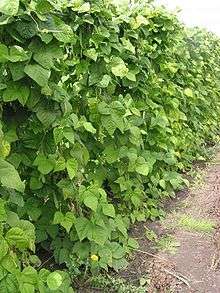Phaseolus
Phaseolus (bean, wild bean)[1] is a genus of herbaceous to woody annual and perennial vines in the family Fabaceae containing about 70 plant species, all native to the Americas, primarily Mesoamerica.[2][3]
| Phaseolus | |
|---|---|
 | |
| P. vulgaris | |
| Scientific classification | |
| Kingdom: | Plantae |
| Clade: | Tracheophytes |
| Clade: | Angiosperms |
| Clade: | Eudicots |
| Clade: | Rosids |
| Order: | Fabales |
| Family: | Fabaceae |
| Subtribe: | Phaseolinae |
| Genus: | Phaseolus L. |
| Type species | |
| Phaseolus vulgaris L. | |
| Species | |
|
See text. | |
| Synonyms | |
| |
It is one of the most economically important legume genera. Five of the species have been domesticated since pre-Columbian times for their beans: P. acutifolius (tepary bean), P. coccineus (runner bean), P. dumosus (year bean), P. lunatus (lima bean), and P. vulgaris (common bean).[4][5] Most prominent among these is the common bean, P. vulgaris, which today is cultivated worldwide in tropical, semitropical, and temperate climates.
Ecology
Phaseolus species are used as food plants by the larvae of some Lepidoptera species, including common swift, garden dart, ghost moth Hypercompe albicornis, H. icasia and the nutmeg.
Etymology
The generic name Phaseolus was introduced by Linnaeus in 1753,[6] borrowed from the Latin phaseolus a combination of phasēlus and the diminutive suffix -olus, in turn borrowed from Greek φάσηλος 'cowpea'.[7] This term is often incorrectly glossed as 'kidney bean', a New World crop, but the word's ultimate origin is unknown.[8]
Taxonomy
Previous classifications placed a number of other well-known legume species in this genus, but they were subsequently reassigned to the genus Vigna, sometimes necessitating a change of species name. For example, older literature refers to the mung bean as Phaseolus aureus, whereas more modern sources classify it as Vigna radiata. Similarly, the snail bean Vigna caracalla was discovered in 1753 and in 1970 moved from Phaseolus to Vigna. The modern understanding of Phaseolus indicates a genus endemic only to the New World.[2]
Species
Species have been organized into eight groups based on phylogenetic clades:[9][10][11]
- Phaseolus angustissimus A. Gray
- Phaseolus filiformis—slimjim bean
- Phaseolus carterae
Leptostachyus group
- Phaseolus leptostachyus
- Phaseolus macvaughii
- Phaseolus micranthus
Lunatus group
- Phaseolus augusti
- Phaseolus bolivianus
- Phaseolus lunatus—lima bean, butter bean
- Phaseolus pachyrrhizoides
- Phaseolus viridis
- Phaseolus mollis
Pauciflorus group
- Phaseolus pauciflorus
- Phaseolus parvulus
- Phaseolus perplexus
- Phaseolus pluriflorus
- Phaseolus tenellus
Pedicellatus group
- Phaseolus altimontanus
- Phaseolus dasycarpus
- Phaseolus esperanzae
- Phaseolus grayanus
- Phaseolus laxiflorus
- Phaseolus neglectus
- Phaseolus pedicellatus
- Phaseolus texensis
Polystachios group
- Phaseolus albinervus
- Phaseolus jaliscanus
- Phaseolus juquilensis
- Phaseolus maculatus—spotted bean
- Phaseolus marechalii
- Phaseolus polystachios
- Phaseolus reticulatus
- Phaseolus ritensis
- Phaseolus smilacifolius
Tuerckheimii group
- Phaseolus chiapasanus
- Phaseolus gladiolatus
- Phaseolus hintonii
- Phaseolus oligospermus
- Phaseolus tuerckheimii
- Phaseolus xanthrotrichus
- Phaseolus zimapanensis
Vulgaris group
- Phaseolus acutifolius—tepary bean
- Phaseolus albescens
- Phaseolus coccineus—runner bean
- Phaseolus costaricensis
- Phaseolus dumosus—year bean
- Phaseolus parvifolius
- Phaseolus persistentus
- Phaseolus vulgaris—common bean, French bean, black bean, kidney bean, pinto bean, green bean
Uncategorized
- Phaseolus amblyosepalus
- Phaseolus anisotrichos
- Phaseolus brevicalyx
- Phaseolus chacoensis
- Phaseolus cibellii
- Phaseolus galactoides
- Phaseolus glabellus
- Phaseolus leucanthus
- Phaseolus macrolepis
- Phaseolus massaiensis
- Phaseolus microcarpus
- Phaseolus nelsonii
- Phaseolus oaxacanus
- Phaseolus plagiocylix
- Phaseolus polymorphus
- Phaseolus sonorensis
- Phaseolus vulcanicus
References
- "Phaseolus". Integrated Taxonomic Information System.
- Delgado-Salinas, A.; Thulin, M.; Pasquet, R.; Weeden, N.; Lavin, M. (2011). "Vigna (Leguminosae) sensu lato: the names and identities of the American segregate genera". American Journal of Botany. 98 (10): 1694–715. doi:10.3732/ajb.1100069. PMID 21980163.
- Freytag, George F.; Debouck, Daniel G. (2002). Taxonomy, distribution, and ecology of the genus Phaseolus (Leguminosae-Papilionoideae) in North America, Mexico and Central America. Botanical Research Institute of Texas. ISBN 1889878111. OCLC 249436749.
- Rosales-Serna, R.; Hernández-Delgado, S.; González-Paz, M.; Acosta-Gallegos, J. A.; Mayek-Pérez, N. (2005). "Genetic Relationships and Diversity Revealed by AFLP Markers in Mexican Common Bean Bred Cultivars". Crop Science. 45 (5): 1951. doi:10.2135/cropsci2004.0582.
- Bitocchi, Elena; Rau, Domenico; Bellucci, Elisa; Rodriguez, Monica; Murgia, Maria L.; Gioia, Tania; Santo, Debora; Nanni, Laura; Attene, Giovanna (2017-05-08). "Beans (Phaseolus ssp.) as a Model for Understanding Crop Evolution". Frontiers in Plant Science. 8. doi:10.3389/fpls.2017.00722. ISSN 1664-462X.
- Linnaeus, Species Plantarum 2:623, cited in Oxford English Dictionary s.v. 'phaseolin'
- Henry George Liddell, Robert Scott, A Greek-English Lexicon s.v. φάσηλος
- Oxford English Dictionary s.v. 'phaseolin'
- ILDIS Version 10.01
- Delgado-Salinas, Alfonso; Bibler, Ryan; Lavin, Matt (2006-10-01). "Phylogeny of the Genus Phaseolus (Leguminosae): A Recent Diversification in an Ancient Landscape". Systematic Botany. 31 (4): 779–791. doi:10.1600/036364406779695960. ISSN 0363-6445.
- Delgado-Salinas, Alfonso; Turley, Tom; Richman, Adam; Lavin, Matt (July 1999). "Phylogenetic Analysis of the Cultivated and Wild Species of Phaseolus (Fabaceae)". Systematic Botany. 24 (3): 438. doi:10.2307/2419699. ISSN 0363-6445. JSTOR 2419699.